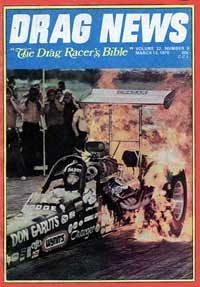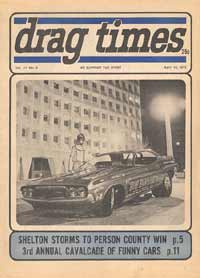| 
1/7/05
Is This The Silver Age Of
Drag Racing Journalism?
 Anybody
over 60 will agree that the Golden Age of drag racing journalism
occurred about 40 years ago, spanning the mid-1960s. As many
as four independent newspapers were published every week.
Drag News, Drag World, Drag Sport Illustrated and Drag Times
all battled to get to press first with the previous weekend’s
choicest scoops, interviews and controversies, plus uncensored
editorial columns, fresh event reports and wild B&W photos. Anybody
over 60 will agree that the Golden Age of drag racing journalism
occurred about 40 years ago, spanning the mid-1960s. As many
as four independent newspapers were published every week.
Drag News, Drag World, Drag Sport Illustrated and Drag Times
all battled to get to press first with the previous weekend’s
choicest scoops, interviews and controversies, plus uncensored
editorial columns, fresh event reports and wild B&W photos.
It was pretty much downhill after that, until the advent
of electronic publishing. In particular, credit is due to
Nitronic Research (1995-2003) for sparking the renaissance
of timely reporting and independent editorial opinions that
we take for granted today. Nitronic founder Cole Coonce didn’t
set out to start a revolution, nor even a magazine; only a
forum for communication among nostalgia racers and fans, whose
hobby was basically being ignored by publishers and television
producers.
 What
distinguished Cole’s baby from mere chat rooms or user
groups were the candid interviews and feature articles that
he posted, plus the professional oversight so lacking in Web
forums. Taking a page right out of Drag News, Coonce even
instituted a Top Ten Mr. Eliminator List that enticed AA/Fuel
Dragster teams to challenge one another during event qualifying.
The hotly-contested Nitronic Research Five-Second Club was
another popular gimmick, patterned after Cragar’s back-motored
promotion of the 1970s. What
distinguished Cole’s baby from mere chat rooms or user
groups were the candid interviews and feature articles that
he posted, plus the professional oversight so lacking in Web
forums. Taking a page right out of Drag News, Coonce even
instituted a Top Ten Mr. Eliminator List that enticed AA/Fuel
Dragster teams to challenge one another during event qualifying.
The hotly-contested Nitronic Research Five-Second Club was
another popular gimmick, patterned after Cragar’s back-motored
promotion of the 1970s.
There’s even an indirect link to what you’re
reading right now: Among those taking notice of NR was Jeff
Burk, a print veteran (Midwest Racer; Petersen’s Drag
Racing; Super Stock & Drag Illustrated) who had been frustrated
in attempts to secure backing for a traditional newsstand
publication. Burk thought enough of Coonce’s creation
to investigate a purchase, but decided to invest the asking
price in the launch of Drag Racing Online, instead.
ADVERTISEMENT
 |
Coincidentally, another would-be publisher, Bobby Bennett,
was simultaneously planning Competition Plus.com. Thus did
both electronic magazines debut in 1999 — just in time
for the Dot-com Bust, the stock-market crash and the terrorist
attacks, events that combined to stifle Web advertising and,
consequently, wipe out so many fledgling e-zines.
Lacking income from two of the publishing industry’s
three traditional sources of revenue (subscriptions and newsstand
sales), an online publication is totally dependent on advertising.
As recently as 2003, Internet “experts” were united
in predicting that it would be many years before e-zines could
be expected to attract enough advertisers to pay the bills,
let alone generate a profit.

|
